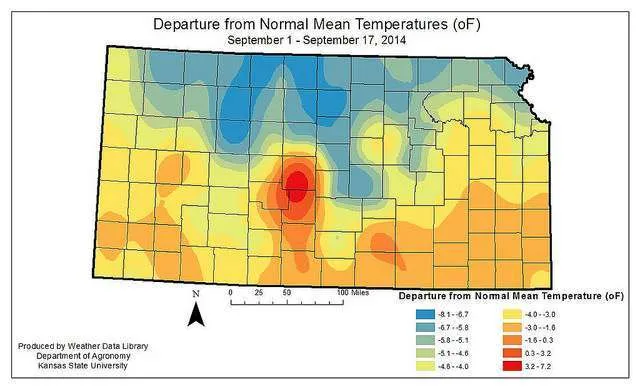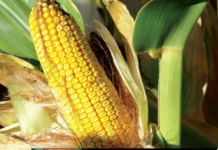
September temperatures fall below 30-year average
MANHATTAN, Kan. – From time to time over the past few months it seemed like fall was trying to crowd out summer, and now it’s a little more serious. The latest cold snap may have been enough to impact grain filling and test weight for Kansas’ summer row crops, especially sorghum and soybeans, according to a Kansas State University agronomist.
“Based on preliminary temperatures, the lowest temperatures recorded around the state of Kansas may have a potential impact on the grain filling and final test weight for summer row crops, especially sorghum and soybean, since corn is close to 50 percent mature,” said Ignacio Ciampitti, crop specialist with K-State Research and Extension.
“In the last 17 days, we have recorded temperatures below 35 degrees F for several counties around the state,” said Mary Knapp, assistant state climatologist for Kansas. “The county with the lowest temperature was Osborne with 29 degrees F, but Ellis, Trego, Ness, and Decatur counties also presented lowest temperatures around 30 to 31 degrees.”
The northwestern and north-central corners of the state particularly have experienced the low temperatures. The central part of the state saw temperatures as low as 33 to 37 degrees F, while the south region (west, central and eastern portions) had overall temperatures above 40 degrees.
The temperatures experienced in the last 17 days fell below the 30-year average for 101 of Kansas’ 105 counties. For the north-central counties of Smith, Phillips, Mitchell, Graham, Rooks, Osborne and Trego, the departure was close to 7 degrees F below the 30-year average, Knapp said.
How temperatures affect crops
In most of the state, Ciampitti said, the state’s corn crop is beyond the dent stage (50 percent mature). Corn is affected with temperatures below or at 32 degrees F. Lower temperatures can produce an equivalent or greater damage even when the exposure time is relatively minimal. Clear skies, minimum humidity and no wind conditions increase freeze damage even with temperatures above 32 degrees.
“Any freeze damage at this point of the season will hardly produce any visible symptoms but can impact the final test weight and potentially seed quality (depending on the growth stage),” Ciampitti said.
Researchers in Wisconsin found that a light frost (affecting leaves) will produce a 5 percent yield reduction, while a killing frost (affecting leaf and stalk) will reduce yields by 12 percent, even when the corn is at the dent stage. The only point in which corn is not affected at all by freeze is at the black layer stage, Ciampitti said.
“Kansas’ soybean is into the final reproductive stages (dropping leaves),” the agronomist said. “Temperatures below 32 degrees can interrupt grain filling and impact yield, meaning lower test weight and seed quality.”
Necrosis of the leaf canopy is a visible symptom of freeze damage in soybeans, he added. Absolute temperature is more important than the duration of the cold stress – especially if temperatures drop lower than 28 degrees F. The timing of the freeze effect will increase the likelihood of affecting yields. As the crop approaches maturity, the impact of a freeze event on soybean yields declines.
The Kansas sorghum crop is more than halfway coloring (14 percent mature). Low temperatures will reduce seed growth and affect final test weight and seed quality.
“A freeze will kill sorghum if the stalks are frozen and impair the flow of assimilates and nutrients to the grain,” Ciampitti said. “A freeze at the hard-dough stage (before grain matures) will produce lower weight and chaffy seeds.”
Story by: Mary Lou Peter




